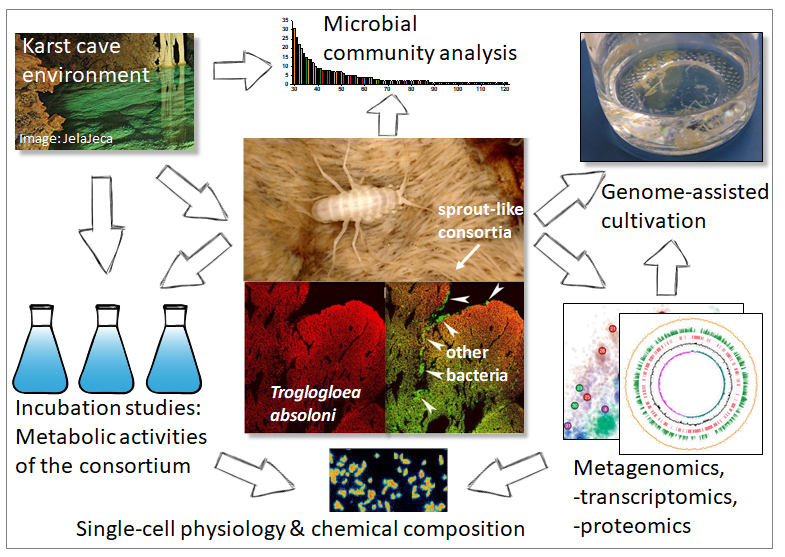BIOLOGY OF MACROSCOPIC BACTERIAL CONSORTIA FROM KARST CAVE STREAMS
Dinaric karst caves are unique ecosystems that host an extraordinarily high biodiversity. Recently, centimeter-long “sprout-like” microbial consortia that grow on karst cave stream bed rocks were structurally and phylogenetically described. The major organism forming these consortia is an uncultured novel member of the Nitrospirae phylum called Troglogloea absoloni. The consortia also contain uncultured Betaproteobacteria and few other microbes. Interestingly, T. absoloni is the closest known, living ancestral relative of the genus Nitrospira – a widespread genus of autotrophic nitrite-oxidizing bacteria and complete nitrifiers (comammox). However, the biology of T. absoloni and its symbionts in the huge consortia is unexplored. First metagenomic data obtained in our lab indicate an autotrophic lifestyle based on a yet unknown energy source.
Aims: This PhD project will characterize the T. absoloni consortia with respect to their metabolic capabilities, microbe-microbe interactions, and ecological roles in the caves. Insights into the biology of T. absoloni, a microbial living fossil, may reveal unknown chemolithoautotrophic metabolisms and illuminate the evolution of the extremely versatile Nitrospirae.
Approach: The biology of the T. absoloni consortia will be tackled by a combination of metagenomics, gene/protein expression studies, physiological experiments, and single-cell isotope labeling and chemical imaging (Raman microspectroscopy, NanoSIMS). By integrating data from these different techniques, a picture of the metabolic potentials and interactions of the consortia members will be obtained. In addition to these cultivation-independent methods, attempts to maintain living consortia in the lab will be made. Field trips to Dinaric karst caves for collecting biomass samples and environmental data will complement the lab studies.
Relevance: Karst caves are fragile ecosystems threatened by human activities, such as nutrient pollution from agriculture. Understanding their microbiological basis will help predict how these systems respond to disturbances and help develop protection measures. Deciphering the enigmatic metabolism of T. absoloni and its symbionts may expand our knowledge of chemolithoautotrophic life and biogeochemical cycles.
Student: Alisa Socolov
Faculty: Daims (PI), Wagner, Rattei
Funding: FWF doc.fund project MAINTAIN

Selected Publications:
Kostanjsek, R., Pasic, L., Daims, H., & Sket, B. Structure and community composition of sprout-like bacterial aggregates in a Dinaric Karst subterranean stream. Microb. Ecol. 66: 5–18 (2013).
Farnleitner, A.H., Wilhartitz, I., Ryzinska, G., Kirschner, A.K.T., Stadler, H., Burtscher, M.M., et al. Bacterial dynamics in spring water of alpine karst aquifers indicates the presence of stable autochthonous microbial endokarst communities. Environ. Microbiol. 7: 1248–1259 (2005).
Daims, H., Lebedeva, E.V., Pjevac, P., Han, P., Herbold, C., Albertsen, M., et al. Complete nitrification by Nitrospira bacteria. Nature 528: 504–509 (2015).
Lücker, S., Wagner, M., Maixner, F., Pelletier, E., Koch, H., Vacherie, B., et al. A Nitrospira metagenome illuminates the physiology and evolution of globally important nitrite-oxidizing bacteria. Proc. Natl. Acad. Sci. U. S. A. 107: 13479–13484 (2010).



